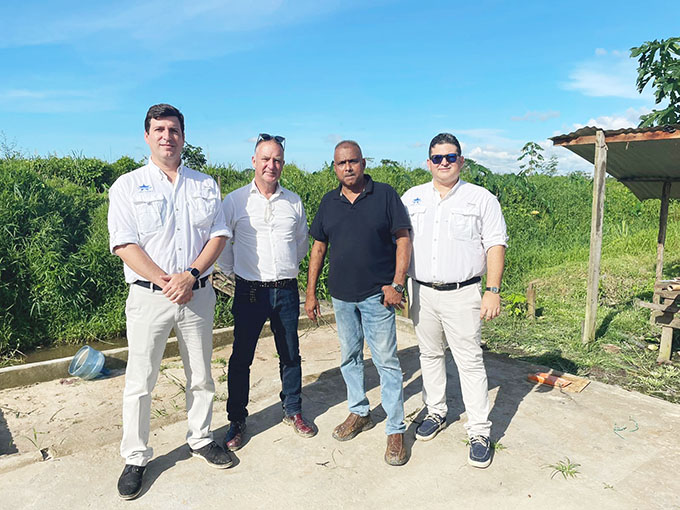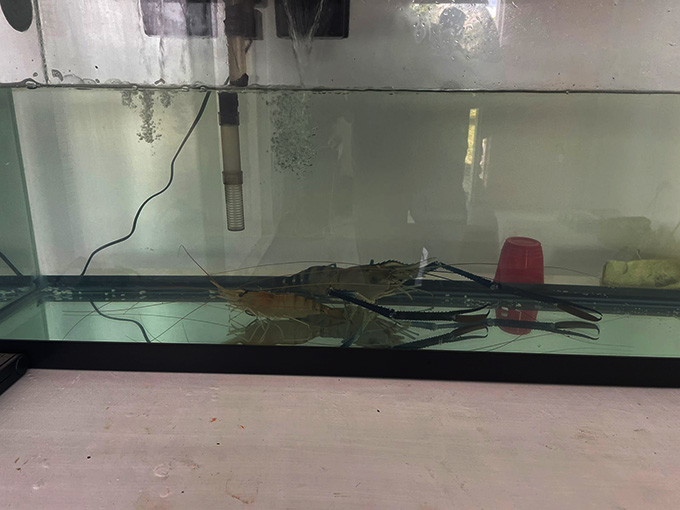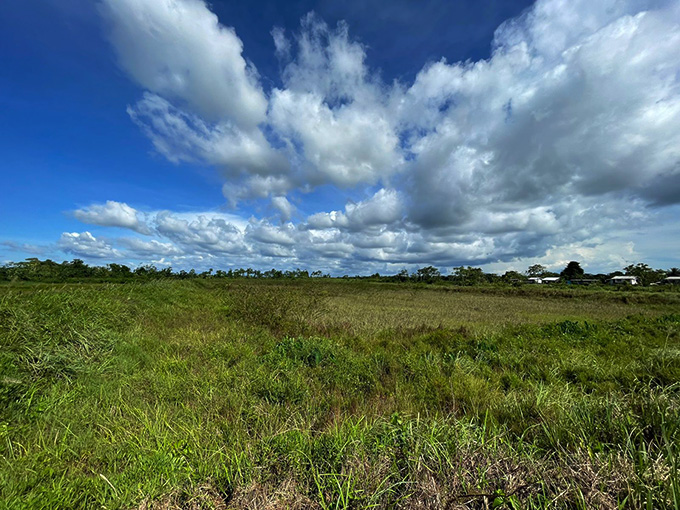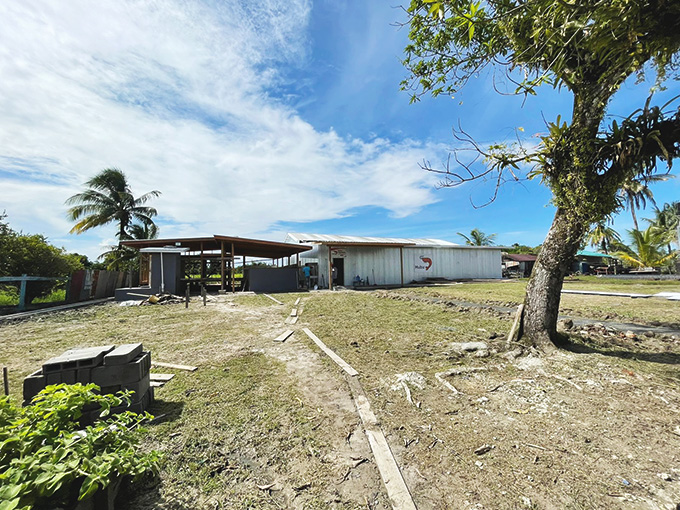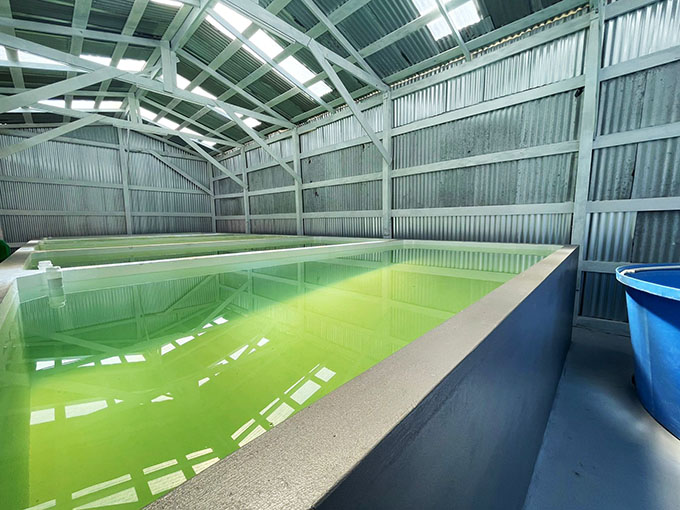-hoping to target 30% of UK prawns market
The US$25m Hubu Aquafarms project aims to revolutionise aquaculture here with high technology and organic harvests and it hopes to eventually net 30% of the UK’s prawns market.
“This is not agriculture. This is a tech business. There’s no longer agriculture. You know, when people think of agriculture, they think of boots and a spade, and we say none of this because the road we are taking this is a tech-driven industry,” Executive Director Simon Shaw said as he spoke of the company’s plans to integrate technology into its farming practices. The project will incorporate technology ranging from micro-nano bubble generators in its breeding ponds to drones to feed its crustaceans, and hydrophones to determine feed time and collecting data among others.
Shaw, who is an engineer by profession, explained that through technology, they will be able to collect data and insert a control system on the farm to monitor weather conditions, ph meters to assess how acidic or basic the water is, and oxygen sensors and hydro-phones to listen to the activities of the crustaceans on the farm.
“With the hydrophones we can listen to the stream. You can tell when they aren’t feeding because they make a clicking sound; when they require feed and you hear when they stop clicking and that means they’ve had enough” said Shaw, who has been working along with the farm’s founder and initial investor, Sheik Rahman, to get the project off the ground. He added that the micro-nano bubble generator will be used to keep breeding stocks healthy, eliminating the need for antibiotics. According to Shaw, the nano bubbles generator in the breeding ponds will function as a natural antioxidant to prevent diseases.
Expanding on the use of drones, Shaw said they have already partnered with a UK company to map the farm. He added survey markers are already in place to ensure there is accurate positioning of the drones. This is necessary to prevent spillage of feed and to gather accurate data. The drones will eliminate the need for intensive labour when it comes to feeding stocks and monitoring activities around the farm.
“So you know these fertilizer spraying drones. Yeah, well, we’re just going to use it to spread the feed. So in other words, we’ll have a control room here… You will say go and feed pond number 26 and a few drones will go off and come back again. So the drones will be used for surveillance, monitoring and feeding,” Shaw pointed out.
Technologically-based farming activities are intended to illustrate to farmers and young people its potential and the investors believe their concept will provide new job opportunities to graduates, specifically from the University of Guyana and the Guyana School of Agriculture and will also encourage more persons to get involved in STEM-related activities. The use of technology on the farms will be rolled out in phases and should be in full use by 2024.
The company has some 600 acres to execute its vision, however, they will commence operations on only 10 acres of land. The ponds at Hubu have already been constructed but inactivity have caused them to be filled with vegetation. Global shipping constraints was one factor that delayed preparatory works and Shaw related it was not feasible for them to commence those works when materials were being delayed. Once the materials arrive they will begin to prepare the ponds to transfer the larvae. At the hatchery, Shaw explained that they will not only breed larvae for their own use but to retail to other farmers who wish to enter the market. They will also grow their own plankton and algae to feed the larvae. The breeding conditions at the hatchery will be closely monitored and controlled to ensure ph levels are on par with industry standards. The company will rear different breeds of shrimp such as the Giant River Prawns, the White Leg Shrimp and the Asian Tiger Prawns.
Developers
But once operations are up and running, the developers will be building an additional hatchery for other species of prawns and eventually will move the hatchery to Hubu. “It’ll be a much bigger hatchery. The idea is that we want to provide larvae to other farmers so they can start up because the most complicated thing is running the hatchery and it is most capital intensive. So once we’ve got the hatchery running, we’ll be able to basically supply the farmers the larvae and will be able to supply them the feed,” Shaw explained. While it is their vision to become a major exporter to Europe and compete with producers from countries in the Caribbean and South America, the first harvest will be supplied to the local market. If the company remains on schedule they will be able to have their first harvest by September. Asked if there is an export market for Guyana to enter at this stage, Shaw responded in the affirmative since their method of rearing will be organic. Organic produce is in high demand globally. He added that they will not be using any form of chemical and Gene Modified Organisms (GMOs) to breed and rear their stocks.
“We’re going to produce organic shrimp, you know, we’re not going to use any antibiotics. We’re not going to use any anti fungicide or anything. (It’s) going to be purely organic shrimp. And the reason is because that’s what the demand is in Europe and you can get a better price if you go organic,” he explained.
Additionally, Shaw asserted that their organic line will be tastier since they will not be produced in chemical ponds and fed with GMOs and antibiotics. He also stated that on the processing line they will not be washing their harvest with chlorine as practiced in some countries. “So we are very conscious of the environment so that’s why we are doing this recirculating aquaculture system. Once we fill these ponds, the water will just go round and round. Basically, we will have a pump station and the water will go to the pump station. It will be filtered, UV treated… and sent back to the ponds and it’ll continue. It’s just like a big aquarium like you have in your house,” he said.
In addition, the company will be collaborating with a Panamanian feed development company, Grupo Calesa, to generate their own special mix of feeds for the prawns and shrimp. With this initiative, Shaw said they will be able produce shrimp and prawns to a certain standard and size. Currently, the investors are working to have the farm up and running and have already completed the construction of the hatchery at Le Destin, EBE, a short distance away from its farm where rearing will be done. At the hatchery, once the initial larvae are imported the company will be able produce some 5 million larvae a month.
30 percent of the market
The company is seeking to access up to 30% of the UK market. The UK imports just around 80,000 tonnes of prawns per year. “If we’re producing, you know, 25,000 tonnes of prawns a year we can access 30% of the UK market, from this farm. So the potential for the whole of Europe is just huge,” Shaw pointed out. At start up, Hubu Aquafarms will be able to produce some 400 tonnes of prawns per year with three to four harvests. The global shrimp market is projected to grow from US$33.81 billion in 2021 to US$56.63 billion by 2028, a 6.81% growth, Fortune Business Insights reported. He also added that once production is at its peak they can possibly rival the Ecuadorean market when it comes to export and transporting fresher produce. Guyana, he said, is closer to Tilbury, UK by 3,665 KM than Guyaquil, Ecuador.
Additionally, Shaw related that they will be engaging in horticultural farming. He explained that in a bid to manage their waste, they will occupy a portion of land to cultivate nontraditional crops. “We will use the waste as fertilizers to grow strawberries, cauliflower, berries and broccoli. Basically any crop that is imported we will grow. We will also look to grow seed potatoes for farmers,” he explained. The majority of the produce will be used to meet the needs of the Barbadian market. The horticulture farm is expected to come on stream by early 2023. Shaw explained that in the initial stage they will have to bring in Indonesians who are knowledgeable in operating such farms.
The company will be engaged in semi-intensive farming as done in Indonesia. The imported labour will be used in the startup and to train Guyanese. When the project comes fully on stream in 2024, with a processing and packing facility, some 100 persons are expected to be employed. He went on to explain that the majority of the jobs will be in place when the fish processing and feed mill comes on stream. They are aiming to hire locals right from the community and provide flexible working hours to people. “You know, we’ve got to sort of build up our labour. You know, once we’ve got a processing facility and feed mill, we are going to have a lot of people doing processing and this will create good job opportunities, particularly for the women in the Hubu area,” he added.
Biomass power generation
Considering green energy to be a part of their business operation, Shaw said they will be setting up a small-scale biomass plant to generate electricity. He stated that they have already signed an agreement with a company in the United States to engage in trials and research on the energy alternative. With vast amounts of wood shavings and paddy shells discarded by sawmills and rice mills along the river banks, Shaw said they are looking to recover that and convert those into energy for the farm. “So if we can take sawdust waste, with rice husks and produce energy, we can reduce our footprint. We don’t want to run our farm on diesel generators. This will be one of the first farms in the world equipped with a biomass sensor…and we are going to do a training and research programme to see how feasible this is,” the director added. When operations commence the company will be utilizing power from the national grid and a generator.
He stated that all these initiatives will allow Guyana to enter the market from the top rather than at the bottom as consumers will be aware of the carefully selected conditions under which the prawns are reared. On this note, Shaw explained further that they will be seeking certification from the Aquaculture Stewardship Council [ASC]. ASC develops and manages the strictest standards in the industry to distinguish farms. Their labeling on products assures consumers that products were reared on farms that care for the environment, their workers and the communities in which they operate.
Barbados partnership
The company, through the Guyana Barbados food terminal, is also assisting the island in setting up a small-scale aqua farm. Shaw stated that they will be sending one of their imported workers to the country to assist in the setting up of the farm. “It’s an agreement between the two governments and we were just asked to help them. So we’re going to supply larvae to Barbados, hopefully we’ll supply them the feed, and we’ll supply one of our Indonesian guys to go and get it started. But what they’re doing in Barbados is much, much smaller,” Shaw added. The company initially started with Rahman in 2000 but he was unable to secure the necessary investments in the last 20 years after his investments went downhill. The day when he was importing 40,000 larvae from the US, tragedy struck with the September 11 World Trade Center Towers tragedy. This resulted in all planes being grounded and the larva dying at an airport in Atlanta. “I got a hold of a company in the US. We did an experiment and it was perfect. We started developing ponds and we grew two crops. It was perfect and we were starting to expand,” he explained.
After losing his investment, he was unable to secure financing and local banks were not open to grant agricultural loans at the time. This story has changed, however, and Rahman said several banks have now approached him offering financing. Recently, his company was able to secure a grant from a floating oil offshore platform operator, SBM offshore. The support received from SBM Offshore has fueled the realization of a lifelong dream and kick-started production once again. He stated that for years he had experimented with the venture and was convinced that this was a suitable and much needed investment.
According to him, once the necessary infrastructure is in place it is a “no brainer” investment as the returns are much more lucrative than cultivating traditional crops. He stated too that when he first started the venture, it was heavily supported by the late Minister of Agriculture, Satyadeow Sawh, who had seen his vision. “I had predicted what was going to happen with the fish catches but nobody paid attention and really believed this was the way… Guyana has the perfect 24/7 condition for aquaculture. What we needed was a push and support and financing… We are here again now and I am really excited about this…” Rahman posited.
